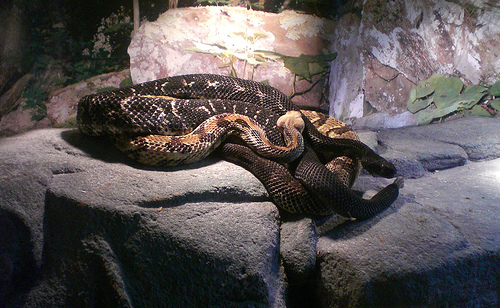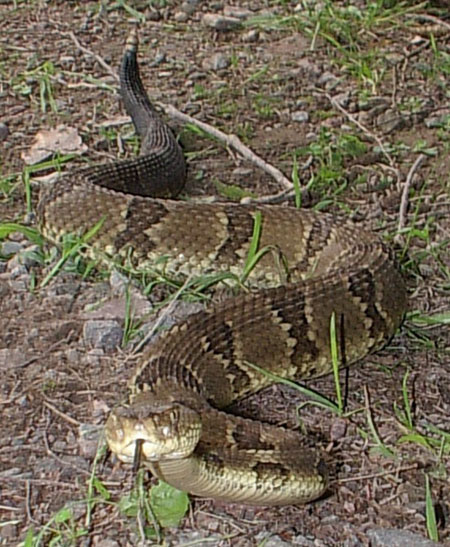Reproduction
Timber rattlesnakes have a very complex reproduction cycle,
as do most animals. They undergo sexual reproduction only and
are dioecious, meaning that males and females exist as separate
individuals. For males, sexual maturity is reached at around
three to four years of age, while females can take up to eleven
years. Since timber rattlesnakes have life expectancies of about
twenty years, females are only able to reproduce two or three
times during their lifetime. For this reason, females tend to
breed only every t wo
to four years, three being the most common. Breeding season usually occurs in the spring and fall, but prime
breeding times occur in July and August. Mating rituals are
highly competitive, and consist of males participating in
combative wrestling matches with other males in order to gain
the attention of a female. The successful male will go on to
mate with the female, who is capable of storing sperm for up to
a year. The sperm is stored during the winter months for use in
the spring when the females ovulate. In June, the female’s ova
are fertilized internally and thus, gestation begins. Like
other pit vipers, timber rattlesnakes are ovoviviparous, meaning
they do not lay eggs outside of the body. Instead, the embryos
develop in eggs that are incubated and hatched within the
mother’s body and then birthed as live young. Each egg contains
an amnion, which serves as a protective membrane that surrounds
the developing embryo. The egg also contains an egg yolk sac
that provides nourishment for the developing embryo as well as
many other membranes that aid in the embryo’s growth. During
gestation, females spend most of their time near their
hibernation dens or basking in the sun to keep their body
temperature at an optimal level. Also, contrary to mammals like
us, females tend to eat less during this period of gestation and
remain relatively inactive. The yolk sac mentioned earlier
provides sufficient nourishment during embryonic development
that newborns do not usually need to feed until well after
birth. Therefore, overconsumption by the mother during
gestation is unnecessary. By late August and early
wo
to four years, three being the most common. Breeding season usually occurs in the spring and fall, but prime
breeding times occur in July and August. Mating rituals are
highly competitive, and consist of males participating in
combative wrestling matches with other males in order to gain
the attention of a female. The successful male will go on to
mate with the female, who is capable of storing sperm for up to
a year. The sperm is stored during the winter months for use in
the spring when the females ovulate. In June, the female’s ova
are fertilized internally and thus, gestation begins. Like
other pit vipers, timber rattlesnakes are ovoviviparous, meaning
they do not lay eggs outside of the body. Instead, the embryos
develop in eggs that are incubated and hatched within the
mother’s body and then birthed as live young. Each egg contains
an amnion, which serves as a protective membrane that surrounds
the developing embryo. The egg also contains an egg yolk sac
that provides nourishment for the developing embryo as well as
many other membranes that aid in the embryo’s growth. During
gestation, females spend most of their time near their
hibernation dens or basking in the sun to keep their body
temperature at an optimal level. Also, contrary to mammals like
us, females tend to eat less during this period of gestation and
remain relatively inactive. The yolk sac mentioned earlier
provides sufficient nourishment during embryonic development
that newborns do not usually need to feed until well after
birth. Therefore, overconsumption by the mother during
gestation is unnecessary. By late August and early
 September, gravid females are about ready to
giv
September, gravid females are about ready to
giv e birth. Litter
size can vary greatly among different populations, but the
typical range is from about
5 to as many as 20 newborns. After hatching inside the female’s
uterus, the young are born live and are encased in individual
membranes similar to that of the amnion. Each rattlesnake can
be up to 7 to 13 inches in length when born and are capable of
delivering venomous bites equivalent in danger to that of a
full-grown rattlesnake. Young timber rattlesnakes, like in
the picture to the right, possess very small rattles within the
first few years of life. After their skin sheds a
few times, rattles will develop to their full size. During the
first week, mothers will provide shelter and protection for
their young from predators, but after that, they exhibit very
little parental care.
e birth. Litter
size can vary greatly among different populations, but the
typical range is from about
5 to as many as 20 newborns. After hatching inside the female’s
uterus, the young are born live and are encased in individual
membranes similar to that of the amnion. Each rattlesnake can
be up to 7 to 13 inches in length when born and are capable of
delivering venomous bites equivalent in danger to that of a
full-grown rattlesnake. Young timber rattlesnakes, like in
the picture to the right, possess very small rattles within the
first few years of life. After their skin sheds a
few times, rattles will develop to their full size. During the
first week, mothers will provide shelter and protection for
their young from predators, but after that, they exhibit very
little parental care.
Back To Home Page
To learn more about the Nutrition/Interactions of this organism, click
here